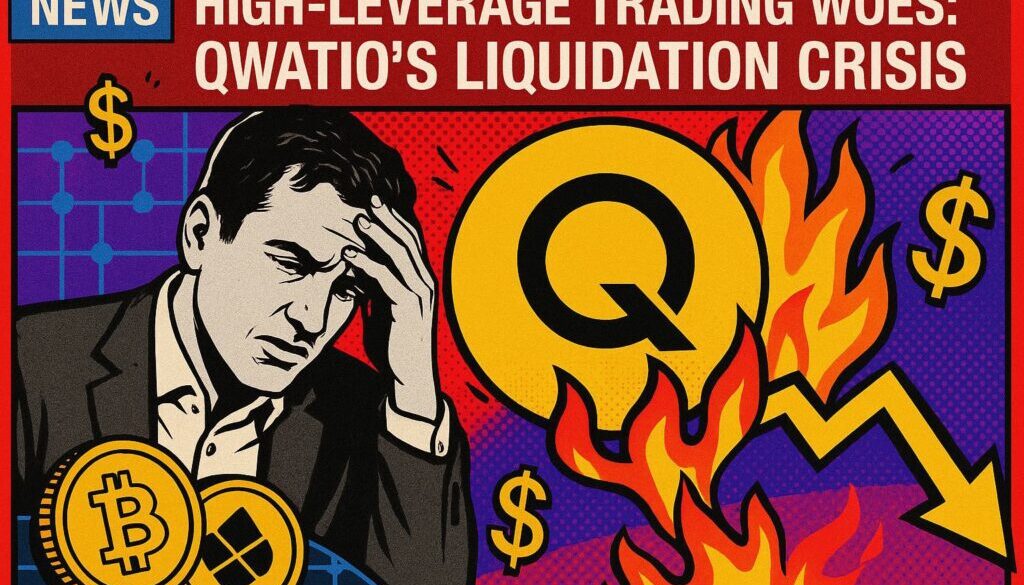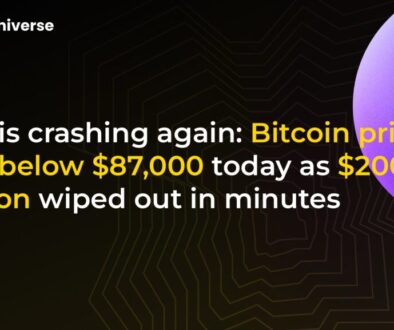High-Leverage Trading Woes: Qwatio’s Liquidation Crisis

High-Leverage Trading Woes: Qwatio’s Liquidation Crisis
The cryptocurrency market is known for its exhilarating volatility, offering both immense opportunities and significant risks. For traders employing high leverage, this volatility can be a double-edged sword, magnifying gains but also devastating losses. A recent case involving a trader named Qwatio on the Hyperliquid platform vividly illustrates the perils of aggressive, high-leverage strategies, especially when betting against a strong market trend.
Qwatio’s Liquidation Crisis: A Stark Warning
In a span of just five hours, a trader known as Qwatio faced a staggering eight liquidations on Hyperliquid. This rapid series of events unfolded as the broader cryptocurrency market experienced a notable surge, rising by 1.78%. This market upturn was reportedly spurred by positive macroeconomic news, specifically a US-Vietnam trade agreement, which injected fresh optimism into the digital asset space.
As the market rallied, Bitcoin (BTC) climbed by 2.5% to reach $108,766, while Ethereum (ETH) saw an even more impressive surge of 5.8% to hit $2,568. Qwatio, however, had positioned himself with high-leverage short bets, essentially wagering against this market rally. As prices continued to climb, his short positions suffered immensely, leading to repeated liquidations.
The consequences were dire: Qwatio’s losses exceeded a staggering $15 million over a period of ten days. Analytics firm Lookonchain highlighted these multiple liquidations, serving as a stark reminder of the significant dangers inherent in high-leverage trading, particularly when market sentiment shifts unexpectedly.
Qwatio was not alone in facing significant setbacks. Another trader, 0xFa5D, also encountered substantial losses, reportedly over $6.8 million, after attempting to recover previous losses with a risky short position on Ethereum. These incidents underscore the immense pressure and rapid capital erosion that can occur in highly leveraged crypto trading.
However, it’s worth noting that not all market navigation involves such high-stakes directional bets. In contrast to Qwatio’s experience, one trader managed to turn a modest $6,800 into an impressive $1.5 million without making any directional bets. This highlights that alternative, less risky strategies can also yield significant returns, even in volatile conditions.
What is High-Leverage Trading in Crypto?
High-leverage trading in the cryptocurrency market involves using borrowed capital to amplify trading positions. Essentially, traders can control a much larger amount of crypto assets with a relatively small initial investment (their own capital). Crypto exchanges often facilitate this by allowing users to trade with leverage ratios that can range from 2x to even 100x or more.
Here’s how it generally works:
- Borrowed Funds: A trader puts up a small portion of the trade’s total value, known as margin. The exchange then lends the remaining funds.
- Amplified Exposure: With leverage, a trader can open a position much larger than their actual capital. For example, with 10x leverage, $1,000 of a trader’s capital can control a $10,000 position.
- Magnified Outcomes: The core appeal of leverage is its ability to magnify potential profits. If the market moves in the trader’s favor, even a small price change can result in substantial percentage gains on the initial capital.
However, this amplification works both ways. The very mechanism that can boost profits also dramatically increases the risk of losses. In the highly volatile crypto market, small adverse price movements can quickly erode a trader’s margin. When losses reach a certain point, the exchange automatically closes the position to prevent further losses to the borrowed funds. This forced closure is known as a liquidation.
The inherent volatility of cryptocurrencies means that prices can swing wildly in short periods. Combining this with high leverage creates an extremely precarious situation where a trader’s entire capital can be wiped out in minutes, as Qwatio’s case clearly demonstrates.
Navigating the Storm: Essential Risk Management Strategies
Given the amplified risks, effective risk management is not just advisable but absolutely critical for anyone engaging in high-leverage crypto trading. Without robust strategies, even experienced traders can fall victim to market volatility and rapid liquidations. Here are some key risk management techniques:
1. Implement Stop-Loss Orders
- A stop-loss order is an instruction to automatically close a position once it reaches a predetermined price.
- This helps to limit potential losses by ensuring that a trade doesn’t continue to lose money beyond an acceptable threshold.
- It’s a fundamental tool for protecting capital, especially in fast-moving markets where manual intervention might be too slow.
2. Practice Prudent Position Sizing
- Position sizing refers to determining the appropriate amount of capital to allocate to a single trade.
- Instead of betting a large portion of your portfolio on one trade, calculate a position size that aligns with your overall risk tolerance.
- A common rule of thumb is to risk only a small percentage (e.g., 1-2%) of your total trading capital on any single trade.
3. Diversify Your Portfolio
- While not always directly applicable to a single leveraged trade, diversification across different assets or trading strategies can help mitigate overall portfolio risk.
- Avoid putting all your capital into one type of asset or a single high-leverage position.
- Spreading investments can cushion the blow if one particular asset or strategy performs poorly.
4. Understand and Monitor Market Volatility
- The crypto market’s volatility is a constant. Traders should regularly assess market conditions and adjust their strategies accordingly.
- Higher volatility often warrants lower leverage and tighter stop-loss limits.
- Staying informed about macroeconomic news and market sentiment can provide valuable insights into potential price movements.
5. Cultivate Emotional Discipline
- Fear and greed can be powerful drivers of irrational trading decisions, especially when leverage is involved.
- Stick to your trading plan, risk management rules, and avoid impulsive decisions driven by emotions or the desire to recover losses quickly (as seen with 0xFa5D).
- Taking breaks and avoiding overtrading can also contribute to better decision-making.
Conclusion
Qwatio’s dramatic liquidation crisis serves as a powerful cautionary tale about the inherent dangers of high-leverage trading in the highly volatile cryptocurrency market. While leverage offers the allure of amplified gains, it equally magnifies potential losses, leading to rapid capital erosion and forced liquidations.
The incidents highlight that successful trading in crypto, particularly with leverage, demands not just market insight but, more importantly, stringent risk management. Implementing strategies like stop-loss orders, careful position sizing, and maintaining emotional discipline are indispensable for navigating the unpredictable currents of the digital asset world. For those venturing into high-leverage trading, understanding and respecting these risks is the first, and most crucial, step towards long-term survival and potential success.


